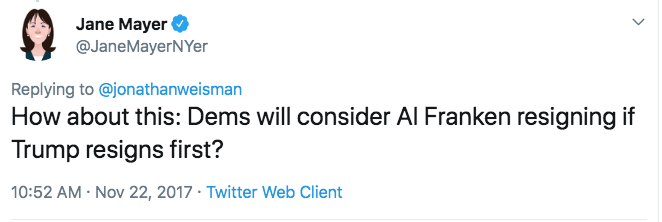
A reporter known for slinging unsubstantiated allegations of improper behavior against conservatives has developed a sudden appreciation for due process and journalistic fact-checking. At least for Democrats. The New Yorker’s Jane Mayer published a robust defense of former U.S. senator Al Franken, who resigned under intense pressure in 2017 after eight women publicly detailed unwanted groping and kissing from him.
Mayer argues that the former Minnesota senator should not have resigned, since one of his accusers was conservative and was associated with political opponents of Franken. As for the other seven, Mayer suggests their complaints about unwanted kisses and groping didn’t rise to the level of seriousness that a Senate resignation would indicate. Yes, Mayer reports, he was known for the unsolicited kissing of women on the mouth, but, we’re assured, he is “a social—not a sexual—’lip-kisser.'” Well, there you go.
Mayer expresses concern that “in an era when women’s accusations of sexual discrimination and harassment are finally being taken seriously, after years of belittlement and dismissal, some see it as offensive to subject accusers to scrutiny. ‘Believe Women’ has become a credo of the #MeToo movement.” Franken learns that “being on the losing side of the #MeToo movement, which he fervently supports, has led him to spend time thinking about such matters as due process, proportionality of punishment, and the consequences of Internet-fuelled outrage.”
The article makes the case that the allegations against Franken weren’t serious enough to warrant him leaving the Senate, a claim that critics of the excesses of the Me Too movement were making at the time. For her part, Mayer was making political arguments:

Mayer quotes Franken friend Sarah Silverman comparing the Franken allegations to others:
Sarah Silverman points out that the photo-op allegations, even if true, are of a different magnitude than the kind of grotesque misconduct that has often been exposed in the #MeToo era. ‘This isn’t Kavanaugh,” she said. “It isn’t Roy Moore.’ In fact, one of Franken’s photo-op accusers told the Huffington Post that she voted for him afterward.
This isn’t Kavanaugh? This isn’t Kavanaugh? You’re darn right this isn’t Kavanaugh, in that while there were pictures of Franken’s described behavior, there is no evidence that Kavanaugh had even met his primary accuser, much less that he tried to rape her. There is no evidence whatsoever that he led a serial gang rape cartel that roamed suburban Maryland, as Michael Avenatti and Julie Swetnick accused him of. Neither is there evidence that he had gone on a nationwide rape spree from California to a boat off Rhode Island.
Of all the people in the world who are in a position to write an article poo-poohing Al Franken’s problems or fretting about journalistic excesses, Jane Mayer may be the very worst choice.
That’s because she has repeatedly published unsubstantiated allegations of sexual impropriety against her political opponents. Most recently she was part of the public relations rollout of Christine Blasey Ford’s allegation against Kavanaugh, publishing one of the stories that released a few details about the allegation to gin up excitement for the Washington Post report that was to come. Ford’s attorney, Debra Katz, is a frequent source for Mayer and her colleagues, including in the Franken article.
Later, Mayer and her colleague published a Kavanaugh hit piece that was remarkable for its shoddy journalism. A Yale University classmate spent six days in the office of an attorney provided by Democrats to reconstruct a memory of nebulous alleged wrongdoing by Kavanaugh.
The classmate had called other classmates asking if they remembered the incident and told them she wasn’t sure if the wrongdoing was committed by Kavnaaugh. In her reconstructed memory, she was seriously inebriated and couldn’t be quite clear what had happened, but she thought Kavanaugh might have exposed himself to her at a party.
Mayer admitted that she ran with the story in order to establish a “pattern of misconduct,” which is important in political battles. Charles Cooke wrote that he struggled to “remember reading a less responsible piece of ‘journalism’ in a major media outlet.” Even The New York Times (whose own Kavanaugh coverage included an article by an avowedly anti-Kavanaugh “reporter” about how Kavanaugh had once thrown ice in a bar fight) admitted the story’s failures. That paper interviewed “several dozen” people but could find no one with first-hand knowledge of the allegations.
As Carrie Severino and I write in “Justice On Trial: The Kavanaugh Confirmation and the Future of the Supreme Court,” “It was at this moment that a number of people on Kavanaugh’s White House team suspected the anti-Kavanaugh forces had finally overplayed their hand. The tide was turning.”
If only Mayer had realized the importance of journalistic integrity and due process a few months ago, when she was the one smearing a man using the flimsiest of sourcing. But Kavanaugh wasn’t the only person Mayer had gone after. She teamed up with Jill Abramson to write “Strange Justice,” an attack on Clarence Thomas. Here’s how Tod Lindberg reviewed it for Commentary:
What does get mentioned is every dirty story anybody has to tell about or against Clarence Thomas—some old, some new, some borrowed, all blue. Mayer and Abramson rehearse, for example, the well-worn saga of Angela Wright, the ‘other woman’ who accused Thomas of making comments about her anatomy and—worse!—asking her for dates. But Wright, as everyone knows by now, would have been a witness whose credibility could be easily knocked down. At the Equal Employment Opportunity Commission (EEOC), Thomas had fired Wright. She had left another job one step ahead of the ax, leaving behind a note denouncing her boss for racism. And she had previously been fired by a Democratic Congressman. Yet, in the alternate universe that Mayer and Abramson construct, if only Wright had been heard, Thomas would have been sunk. Why, even Senators who opposed Thomas can be found to say so! …
Strange Justice presents no damning new facts or records. The only thing new, it seems, is its standard for what constitutes proof. According to the rules of journalism that Abramson and Mayer employ, when facts fail to paint the desired picture, gossip more than suffices for filling in the blanks.
Exaggeration is another technique to which Mayer and Abramson fruitfully resort, but this can be a risky device for journalists to employ, especially if they get caught in the act.
Even Nina Totenberg noted the lack of journalistic integrity in some of the hits against Thomas.
Nevertheless it is good news that Mayer, the funniness of whose errors is matched by her refusal to admit them, is developing an appreciation for due process. May her appreciation for this bedrock principle of innocence-until-guilt-is-proven extend to her political foes as much as her political allies.









